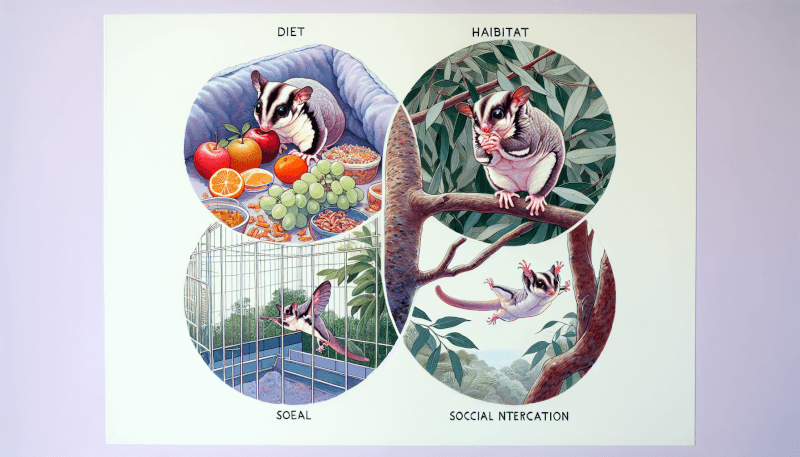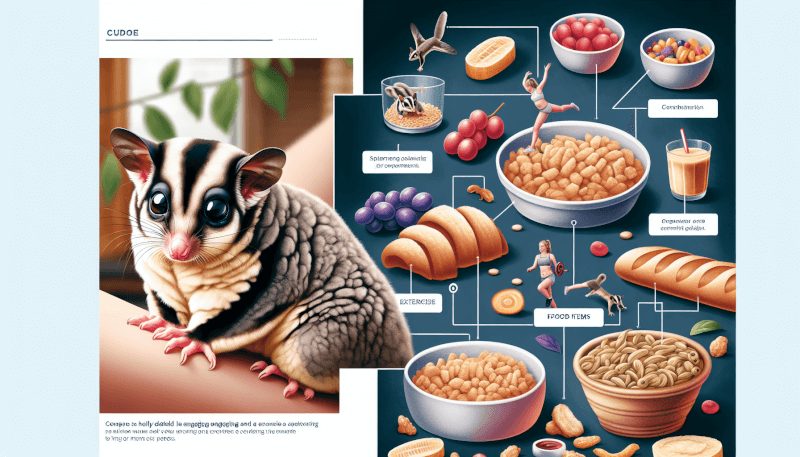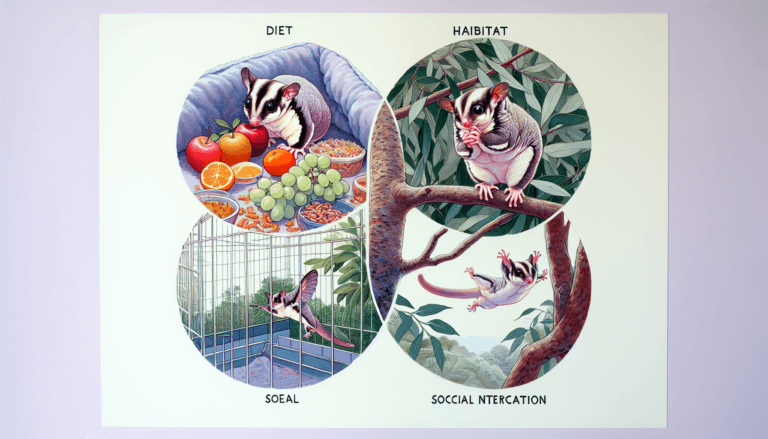What Are The Care Requirements For A Sugar Glider? Owning a sugar glider can be a delightful experience, but it is important to understand the care requirements to ensure their well-being. From providing a suitable habitat to a balanced diet and proper socialization, taking care of a sugar glider requires time, effort, and dedication. In this article, we will explore the essential care requirements for these adorable creatures, equipping you with the knowledge needed to provide them with a comfortable and happy life.
What are the care requirements for a Sugar Glider? – Housing
Cage Size
When it comes to housing your sugar glider, it’s important to provide them with a cage that is spacious enough for them to move around and exercise. A good rule of thumb is to have a cage that is at least 24 inches wide, 24 inches deep, and 36 inches high. This will give your glider plenty of room to jump, climb, and glide. Remember, sugar gliders are active and energetic animals, so it’s crucial to give them enough space to thrive.
Ready for Cat Trivia?
Test your knowledge about cats!

Cage Setup
Setting up the cage for your sugar glider is an essential part of creating a comfortable and stimulating environment for them. Make sure to include multiple levels and platforms for climbing, as well as plenty of branches for them to exercise their natural gliding abilities. Provide nesting boxes for them to sleep and rest, and add soft bedding material such as fleece or shredded paper for their comfort. It’s also a good idea to include a exercise wheel to keep them active during their nocturnal hours.
Temperature and Humidity
Sugar gliders are native to warm and humid climates, so it’s important to maintain suitable temperature and humidity levels in their living space. Keep the ambient temperature between 70-90°F (21-32°C), and avoid placing the cage in direct sunlight or near drafts. Additionally, aim for a humidity level of 50-70%, which can be achieved through misting the cage with water or using a humidifier. Proper temperature and humidity regulation will ensure the well-being and health of your sugar glider.
What are the care requirements for a Sugar Glider? – Diet
The Importance of a Balanced Diet
A balanced diet is crucial for the well-being of your sugar glider. In the wild, they feed on a variety of nectar, fruit, and insects, so it’s important to replicate this diversity in their captive diet. A balanced diet ensures that your sugar glider receives all the necessary nutrients for optimal health and vitality.
Staple Foods
Staple foods should make up the majority of your sugar glider’s diet. These include a specialized sugar glider pellet, which provides key nutrients such as proteins, vitamins, and minerals. Offer this pellet mix as the main portion of their diet to ensure they receive a consistent and balanced source of nutrition.
Supplemental Foods
Supplemental foods should be offered in addition to the staple diet. These can include fresh fruits, vegetables, and small amounts of lean protein sources. Offer a variety of these foods to introduce diversity and ensure a well-rounded diet for your sugar glider. Some examples of suitable supplemental foods include apples, bananas, leafy greens, mealworms, and cooked chicken.
Foods to Avoid
There are certain foods that should be avoided as they can be harmful to sugar gliders. Avoid feeding them foods that are high in sugar, caffeine, or chocolate, as these can be toxic to their system. Additionally, steer clear of foods that are high in fat or salt, as these can lead to health issues such as obesity or heart problems. It’s always best to consult with your veterinarian or a sugar glider nutritionist for a comprehensive list of foods to avoid.

What are the care requirements for a Sugar Glider? – Exercise and Enrichment
Physical Exercise
Sugar gliders are highly active animals that require daily exercise to maintain a healthy lifestyle. Encourage physical exercise by providing them with plenty of space to climb, jump, and glide. Allow them supervised time out of their cage in a safe, glider-proofed room where they can explore and stretch their wings. Consider providing them with an exercise wheel specifically designed for sugar gliders to help fulfill their energy needs.
Cage Setup for Exercise
Create a cage setup that promotes exercise and physical activity. Include different levels, branches, and platforms for climbing and jumping. Hang ropes or vines for them to swing on, and consider adding tunnels or hammocks for added stimulation. Providing a variety of climbing opportunities will help keep your sugar glider active and engaged even while inside their cage.
Toys and Enrichment
Toys and enrichment are essential for keeping your sugar glider mentally stimulated and entertained. Offer a variety of toys such as puzzle feeders, hanging toys, and chew toys to keep their minds and bodies active. Additionally, rotate the toys regularly to prevent boredom and maintain their interest. Remember to always use safe and sugar glider-specific toys to avoid any potential hazards.
What are the care requirements for a Sugar Glider? – Grooming
Bathing
Sugar gliders are naturally clean animals and typically groom themselves, so baths are not necessary unless they get themselves into something particularly sticky or dirty. If required, you can give them a shallow, lukewarm bath using a sugar glider-safe soap. Ensure you thoroughly rinse them with clean water and dry them gently with a soft towel.
Nail Trimming
Regular nail trimming is important to prevent overgrowth and discomfort for your sugar glider. Use specially designed nail clippers or files designed for small animals to trim their nails. Take care not to cut into the quick, which can cause bleeding. If you’re uncertain about how to trim their nails, consult your veterinarian or a professional animal groomer for guidance.
Tooth Care
Sugar gliders have unique dental needs, and it’s essential to maintain their oral health. Providing appropriate chew toys and materials, such as safe wood blocks, will help keep their teeth worn down and healthy. Avoid feeding them sticky or sugary foods that can lead to dental issues. If you suspect any dental problems, consult your veterinarian for a dental evaluation and appropriate treatment.

Socialization
Bonding with Your Sugar Glider
Building a strong bond with your sugar glider is essential for their well-being and happiness in captivity. Spend time with them every day, allowing them to become accustomed to your presence and scent. Offer treats from your hand to create positive associations and gradually increase physical contact as trust is established. Patience, consistency, and gentle interaction will help build a strong bond over time.
Playtime and Interaction
Playtime and interactive sessions are crucial for keeping your sugar glider mentally stimulated and providing social enrichment. Set aside dedicated playtime each day to allow them to explore outside their cage in a safe, glider-proofed space. Offer toys, tunnels, and bonding pouches for them to play and interact with. This not only provides exercise but also fosters a deeper connection between you and your sugar glider.
Multi-Glider Homes
Sugar gliders are sociable animals and thrive in the company of their own kind. Consider adopting a pair or small group of sugar gliders if possible, as this will provide them with companionship and prevent loneliness. Ensure you have a suitable-sized enclosure and monitor their interactions to ensure harmony within the group. If introducing new gliders, do so gradually and under supervision to prevent any potential conflicts.
Healthcare
Regular Veterinary Care
Regular veterinary care is essential for the overall health and well-being of your sugar glider. Schedule routine check-ups with a veterinarian experienced in exotic animals to ensure your glider is in good health and to address any potential concerns promptly. Regular examinations, vaccinations, and fecal tests are part of preventive care to keep your sugar glider happy and healthy.
Common Health Issues
Sugar gliders can be prone to certain health issues, including dental problems, obesity, and nutritional deficiencies. Monitor their weight regularly and ensure they maintain a healthy body condition. Keep an eye out for any changes in behavior or appetite, as these can be indicators of underlying health problems. If any concerning signs arise, consult your veterinarian for a thorough evaluation and appropriate treatment.
Prevention and First Aid
Prevention is always better than cure, and there are steps you can take to minimize the risk of common health issues. Provide a balanced diet, maintain proper temperature and humidity levels, and keep the cage clean to prevent infections and diseases. It’s also essential to have a basic first aid kit on hand and familiarize yourself with common first aid procedures to provide immediate care in case of any emergencies or injuries.

Handling and Training
Handling Techniques
Proper handling techniques are essential to ensure the safety and well-being of your sugar glider. Gently scoop them up with both hands, supporting their entire body, and avoid squeezing or gripping too tightly. It’s important to remain calm and avoid sudden movements, as these can startle or stress your glider. Always approach them from the front to avoid scaring them with any sudden surprises from behind.
Training Tips
Training your sugar glider can help foster trust, establish boundaries, and facilitate easier handling. Start with basic commands such as “up” or “down” using positive reinforcement techniques, such as treats or praise. Be patient and consistent with your training sessions, keeping them short and enjoyable. Gradually increase the complexity of commands as your glider becomes more comfortable and responsive.
Building Trust
Building trust is crucial for a strong bond between you and your sugar glider. Be patient and allow them to approach you on their terms. Avoid making sudden movements or loud noises that could frighten them. Offer rewards such as treats or favorite foods to establish positive associations. Over time, your sugar glider will learn to trust you and feel more comfortable in your presence.
Environment
Quiet and Safe Living Space
Sugar gliders are highly sensitive to their environment, and it’s important to provide them with a quiet and safe living space. Avoid placing their cage near loud noises, such as television or loud music, as this can cause stress or anxiety. Minimize exposure to potential stressors, such as aggressive pets or children, to create a calm and secure atmosphere for your glider.
Avoiding Harmful Household Items
Ensure that the living space for your sugar glider is free from any harmful household items that could pose a danger to their well-being. Remove any toxic plants, chemicals, or cleaning products from their reach. Be cautious of open windows or unsecured doors that could allow for accidental escapes. Always supervise your glider while out of the cage to prevent them from accessing potentially dangerous areas.
Natural Light and Darkness
Reproducing natural light and darkness cycles is important for the well-being of your sugar glider. Provide them with a light schedule that mimics their natural environment, typically 12 hours of darkness and 12 hours of light per day. This helps regulate their internal clock and maintains their natural behaviors. Consider using blackout curtains or blinds to ensure they have a consistent dark period for restful sleep.

Breeding and Reproduction
Breeding Considerations
Breeding sugar gliders should only be undertaken by experienced glider owners and with careful consideration. It’s important to have a suitable pair with good genetic backgrounds and to understand the responsibilities of breeding, including potential health risks and the commitment required for raising joeys. If you’re considering breeding, consult with an experienced breeder or veterinarian for guidance and support.
Joey Care
Raising joeys requires a significant amount of time, effort, and knowledge. Ensure you have a good understanding of their nutritional and developmental needs before embarking on this journey. If you find yourself in a situation where you need to care for orphaned joeys, seek advice from a veterinarian or experienced glider rescue organization to ensure they receive the proper care and support for their growth and development.
Reproductive Health
Keeping your sugar glider’s reproductive health in check is crucial for their overall well-being. It’s recommended to have your glider spayed or neutered if you’re not planning on breeding them, as this eliminates the risk of unwanted pregnancies and potential health complications. Regular check-ups with a veterinarian experienced in exotic animal care can help detect any potential reproductive health issues early and provide appropriate treatment.
Traveling with a Sugar Glider
Traveling by Car
If you need to travel with your sugar glider in a car, it’s important to ensure their safety and comfort. Place them in a suitable travel pouch or carrier that allows for proper ventilation. Secure the carrier in the back seat and avoid placing them near direct airflow from the air conditioning or heating vents. Keep the car at a comfortable temperature and avoid sudden stops or turns that could cause stress or injury.
Flying with a Sugar Glider
Flying with a sugar glider poses additional challenges and considerations. Before booking a flight, research the airlines’ specific requirements and restrictions regarding traveling with exotic animals. It’s important to ensure proper travel documentation, as well as ensuring the safety and well-being of your glider during the journey. Consulting with your veterinarian or an animal travel specialist can provide valuable guidance and advice.
Preparations and Safety Tips
Before traveling with your sugar glider, make sure you have all the necessary supplies, such as food, water, bedding, and any medications they may need. Create a familiar and comfortable environment for them in their carrier or travel pouch by including items with their scent, such as a small piece of bedding from their cage. Offer them treats and reassurance throughout the journey to help reduce stress and keep them calm.
In conclusion, providing proper care for your sugar glider involves creating a suitable living environment, maintaining a balanced diet, ensuring regular exercise and mental enrichment, practicing proper grooming, fostering socialization, and prioritizing their healthcare needs. By following these guidelines and consulting with knowledgeable professionals, you can ensure the well-being and happiness of your sugar glider companion.



